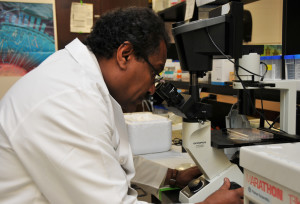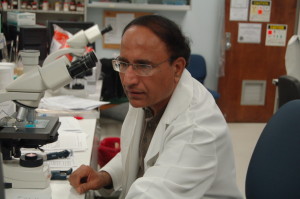Dr. Sartor has been involved in a leadership role with a Phase III trial prolonging survival in advanced prostate cancer. The first trial, subsequently published in Lancet, involved second-line chemotherapy with Cabazitaxel, which gained FDA approval in June 2010. This was the first trial to demonstrate a survival benefit after initial chemotherapy had failed. Dr. Sartor was the international co-principal investigator for this trial and senior author on the Lancet paper.
In the new trial, recently announced, the use of the new isotope Radium 223 has resulted in a prolong survival of a polaroid of patients with advanced metastatic prostate cancer, and this is the first radio-pharmaceutical to prolong life in prostate cancer. Dr. Sartor was the North American principal-investigator in this trial. Dr. Sartor was a local investigator (but without a national leadership role) in a third trial using Abiraterone, which led to a prolongation in survival in metastatic prostate cancer. He is currently involved with his fourth Abiraterone study, which is the first second-line hormonal agent to demonstrate survival benefits. Abiraterone is now FDA approved.
He currently runs approximately ten clinical trials in prostate cancer, and he is a national co-principal investigator in three of these trials.
Asim Abdel-Mageed, PhD
Active Research Projects
“Targeting Tumor-Derived exRNA-Containing Microvesicles by High Throughput Screening”
“Estrogen-ER Axis in Disparity of Prostate Cancer”
“Adipose stem cell-based therapeutic targeting of residual androgens in African Americans with bone metastatic prostate cancer”
Dr. Abdel-Mageed’s laboratory primarily focuses on basic research into the cellular and molecular aspects of urologic diseases, with particular attention given to prostate and bladder cancer. The laboratory has a special interest in identifying molecular determinants of prostate cancer progression, using in-vitro and in-vivo experimental approaches.
Men’s Health (Male Infertility, Sexual Dysfunction, Genitourinary Inflammation, Prostate Diseases, Environmental Reproductive Toxicology, Role of Oxidative Stress/Antioxidants, Sperm Safety Multicenter Clinical Studies, Forensic Applications, Endocrine Disruptors, and Andropause)
Male Infertility:
- Diagnosis
- Treatment
- Assisted Reproduction Technology (ART)
- Oxidative Stress and Role of Antioxidants
- Testicular Toxicology
- Standardized S/E Training Program
- DNA Identification
- Chromosome Evaluation
Sexual Health:
- Erectile Dysfunction (ED)
- Peyronie’s Disease
- Oxidative Stress and Role of Antioxidants
- Role of Stem Cells
Prostate Health:
- BPH
- Prostatitis and GUI
- Lower Urinary Tract Symptoms (LUTS)
- Male Aging (Andropause)
- Hypogonadism & Hormone Replacement
- Prostate Cancer
Manesh Kumar Panner–Selvam, PhD
Dr. Panner–Selvam’s research focus has been on reproductive biology, with expertise in sperm and seminal plasma proteomics. His laboratory uses applied bioinformatics tools to study the role of sperm proteins related to male infertility and to identify potential novel biomarkers.
Active Research Projects
- Understanding the role of seminal exosome proteins associated with sperm dysfunction
- Sperm telomere length as a novel diagnostic marker of DNA damage
- Impact of COVID-19 on male reproduction
Dr. Wayne Hellstrom has been a mentor and a researcher for over 34 years at Tulane. His work significantly attracts medical students as well as residents who present research findings at meetings, such as the American Society of Andrology (ASA), the Sexual Medicine Society of North America (SMSNA), and the American Urological Association (AUA), and who subsequently publish manuscripts regarding such research in highly respected journals.
Active Research Projects
- Patient-derived tunical albuginea Xenograft model: a new animal model of Peyronie’s disease
- Molecular mechanisms of penile traction for penile rehabilitation in a bilateral cavernous nerve crush injury rat model





